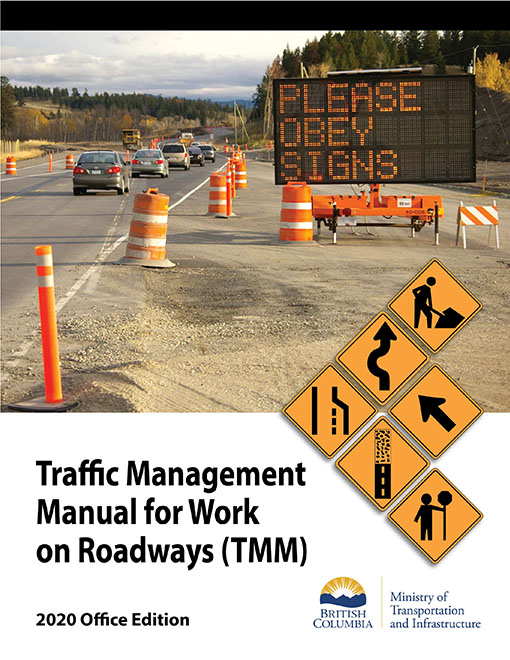Traffic management for work on roadways
Policies, specifications, standards and guidelines to be followed in the development of traffic control systems for the highway system in British Columbia for the Ministry of Transportation and Infrastructure.
Core Documents
Current standards for traffic control in British Columbia.
The 2020 Traffic Management Manual for Work on Roadways (TMM) is an update to the 2015 Interim Traffic Management Manual for Work on Roadways and accounts for edits, comments, and feedback received during the four-year phase in period. The 2020 TMM remains mostly unchanged where the focus of the update was to address:
- Errors and inconsistencies,
- Revisions to bring about further clarification, and
- Additional options and guidance
The 2020 TMM outlines fundamental principles and guidelines for traffic management and traffic control with the goal of protection of workers and the safe and efficient movement of road users through a work zone.
Effective January 2020, the 2020 TMM is to be used for all work on Ministry roadways unless otherwise stated.
- 2020 Traffic Management Manual for Work on Roadways
- 2015 Interim Traffic Management Manual for Work on Roadways
- 1999 Traffic Control Manual for Work on Roadways
- Occupational Health and Safety Regulations Part 18 Traffic Control (WorkSafeBC)
- Traffic Management Guidelines for Work on Roadways (PDF, September 2001)
- Reallocation of Roadway Space for Physical Distancing
- Technical Circulars
Circulars clarify, modify or introduce new practices in the application of technical issues. - Technical Bulletins
Learn about new guidelines or instructions that are necessary prior to major updates to the manual. - Local Area Specifications
Local area specifications outline the minimum acceptable standards of completed work unique to individual service areas. - Sample Traffic Management Plans
- Traffic control person training in B.C.
WorkSafeBC lists training opportunities that meet acceptable standards and requirements - WorkSafeBC Regulations - Part 18 Traffic Control
Study the traffic control health and safety regulations - Cone Zone - Tools for Workers, Employers and Supervisors
Update your document
You must download updates from this site to maintain compliance with current requirement
Contact information
Friendly Url for this page:
www.gov.bc.ca/trafficmanagement
Contact us for information about traffic management.
ENG.Admin@gov.bc.ca
Subscribe
Enter your email address to subscribe to updates of this page.

